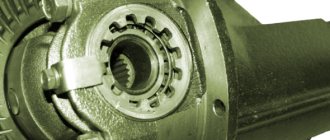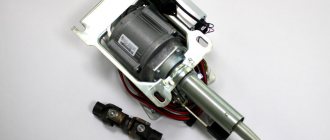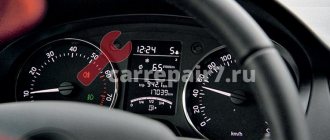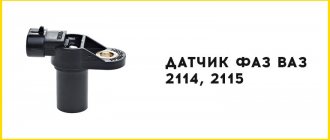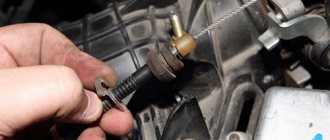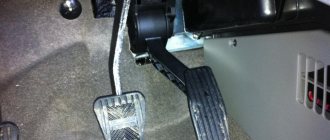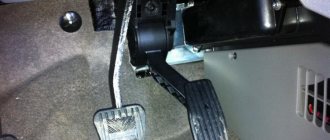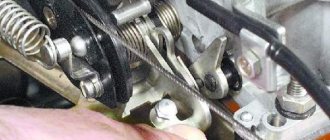Last updated April 2, 2022 at 07:30
A distinctive feature of the fourth generation gas equipment in relation to lower classes is the better preparation of the gas mixture, as well as its accurate, dosed supply into the combustion chambers of the car engine. Due to this, optimal fuel consumption and uniform engine operation in any mode are achieved.
Therefore, the electronics of such systems are equipped with a number of auxiliary parts, including a gas temperature sensor and a 4th generation LPG reducer.
The device, malfunctions, methods of checking and repairing sensors will be discussed in this article.
Functions of temperature elements in gas equipment
From the cylinder to the evaporator, gas fuel (propane-butane mixture) comes in a liquefied state. Passing through the channels of the reducer, the gas is heated by the energy of the car engine coolant and passes into the vapor phase suitable for mixture formation and combustion.
The 4th generation LPG device provides for automatic switching from gasoline to gas. Therefore, the system’s electronic control unit (ECU), based on a signal from the temperature sensor of the reducer-evaporator, sends a command to open the solenoid valve for gas supply to the injectors.
The normal temperature for a car to switch to gas is 35-55°C (set in the program when setting up LPG, depending on climatic conditions and time of year).
Note that this sensor does not measure the temperature of antifreeze/antifreeze; its purpose is to take readings specifically from the coolant housing (gearbox). This was done, among other things, to avoid damage to the evaporator membrane during a cold start.
The gas temperature during injection is not equal to the temperature of the reducer. The gas passes through filters, MAP sensor and injectors, and its condition is also influenced by external factors.
A gas temperature sensor is needed to additionally adjust the fuel supply time. The correction map is set in such a way that when the car switches from gasoline to gas, the gasoline injection time does not change.
The default temperature correction is zero.
Purpose
The importance of such a 4th generation HBO element as a temperature sensor is difficult to overestimate, since the stable operation of the entire system depends on it. It is designed to control compliance with the temperature regime, eliminating the creation of a dangerous situation when the temperature rises above the permissible value.
This element works in conjunction with pressure sensors. This allows for efficient and safe operation of the gas engine. The first device is installed directly into the evaporator reducer and monitors the gas temperature in it. The second device is located in front of the reducer and analyzes the pressure in the gas cylinder. The totality of data received from them makes it possible to form a system that determines the amount of remaining fuel in the cylinder, which is controlled by the ECU and transmitted to the control panel.
Based on the data received from the temperature sensor, fuel injection is automatically adjusted. Violation of this process leads to incorrect operation of all gas equipment. This device eliminates the possibility of cold gas entering the heated reducer. Maintaining temperature balance ensures smooth running of the car. In addition, the device allows the system to determine the moment when fuel injection should occur.
Important: The temperature sensor, like any other used in LPG, is configured for specific equipment in accordance with the technical characteristics of the vehicle. Otherwise, the resulting data will not correspond to the actual parameter values. Online forums and other sources of information do not make it possible to perform this procedure correctly, so you should turn to professionals for help.
Read more: Sony Drive 5 instructions
Types and device
At the heart of gas and gear temperature sensors is a thermistor. The thermistor has a negative characteristic with the designation NTC, i.e. When heated, its resistance decreases.
Thermistor
In 4th generation HBO systems, elements with a nominal value of 1.7 to 10 kilo-ohms are used. But the most common are 2.2 and 4.7 kOhm.
The gearbox temperature sensor has a brass body, differing only in the connector, length and size of the thread.
Gear and gas temperature sensors
Gas sensors can be of plastic or metal construction. The location may include:
- as part of the MAP sensor (we wrote about MAP repair here)
- on a separate tee (cuts into the line in front of the injectors)
- in the nozzle rail
DIY repair
Even a car enthusiast who is not very experienced in this matter can repair the MAP sensor on his own. In particular, the following procedure for replacing the pressure and/or vacuum sensor is proposed.
- The connector is disconnected, the MAP sensor is dismantled, it is inspected, cleaned, and purged.
- Use a sharp screwdriver to pry it up, then remove the plastic cover (or unscrew the screws), opening access to the board with sensors.
- The board is unscrewed and removed from the case.
- The faulty element is soldered off.
- A new sensor is soldered in its place, then an o-ring is put on (the cost of the sensor on aliexpress is 350-450 rubles).
PS-02 pressure sensor brand MPXHZ6400A
Map sensor from Stag PS-02 plus sensor marking - S030/bg9-15
After assembly, all that remains is to put the MAP sensor in its original place, connect the connector and check the functionality of the LPG.
Possible faults
Due to a breakdown of the reducer temperature sensor, the system will not switch to gas or the switch will occur at the wrong time. Due to failure or transmission of false parameters of the gas meter, failures in the operation of the internal combustion engine, as well as overestimation of gas consumption, are possible.
Causes of temperature sensor malfunctions:
- poor installation
- incompatibility of the device with the control unit of gas equipment
- manufacturing defects
- low quality of product components (fake)
- voltage drops in the vehicle's on-board system
When installing gas equipment, it is important not to use twisted wire connections. It is best to use a connector, soldering or connecting sleeves.
It is also worth paying attention to the fastening of the sensor wiring. Wires often break due to vibration directly near the base (this is not always noticeable).
Broken sensor wiring on the gearbox
In addition, wires/contacts should be protected from moisture and corrosion. Carry out system maintenance in a timely manner, as well as buy components with a guarantee from well-known brands.
Design
The appearance of the gas temperature sensor resembles a metal flask with a thread. Two wires come out of it to connect to the ECU system. The device is installed in a groove in the gearbox. The product is selected for a specific type of injection system, as well as the manufacturer of the gas equipment. Automatic switching to gas as the main fuel is performed after heating the coolant to 30 - 50 degrees (depending on the system settings).
Each device differs in its technical parameters and has different resistance. To save the obtained values, it is necessary to correctly select the appropriate type of device.
How to check the 4th generation HBO temperature sensor
There are two ways to determine the performance of temperature sensors.
- Connect the cable for setting up gas equipment. Compare the readings of the meters in the diagnostic program with the real parameters obtained using a pyrometer or thermocouple of a multimeter.
- Set the multimeter to the resistance measurement position and measure the resistance at the sensor contacts (polarity does not matter). At ambient temperature (25°C), the readings must correspond to the nominal value (indicated on the sensor body or in the documentation). If you heat the thermoelement, at least with your hands, its resistance should decrease.
Certificates
Technical regulation TS 004/2011 is where you can find the basic requirements for certification of devices such as measurement sensors. Devices that determine the gas level inside cylinders are no exception. A Customs Union certificate is issued if the equipment successfully passes the test.
Registration of the TP TC Declaration of Conformity is required for devices that are not subject to the normal regulations. This also applies to relays and sensors that do not fall within the range of 50-1000 V. To pass the tests, special events are organized with the participation of the appropriate laboratory.
Voluntary certificates also provide serious advantages over competitors.
Troubleshooting options
Having identified a malfunction, you can buy a new gas temperature sensor or repair the existing one yourself, while saving money.
To do this, you need to warm up the device a little and remove the thermistor from its body. Then buy a thermistor at a radio store (price 30-70 rubles) with the same resistance and size (take a sample). Place a thin heat-shrink tube on the legs of the part.
After installing the thermistor, it is advisable to fill the sensor cavity with thermal paste, and apply epoxy glue or automotive sealant at the end of the hole.
In addition, after soldering the wires to the thermistor terminals, it is important to secure them in such a way as to prevent fracture from vibration during operation . Alternatively, you can make a loop and tighten the wire to the sensor with a clamp.
Video on how you can independently repair a 4th generation LPG temperature sensor:
Instructions for connecting the device
To install gas equipment and a gas temperature sensor in a car, you must have certain skills and experience. If you have never encountered such a task before, then, of course, it is better to turn to specialists.
Installation of gas equipment is carried out in several stages:
- First, the gearbox is installed;
- then all oil pipes are connected;
- preparing a place for mounting the cylinder;
- nozzles are being installed;
- the entire system is connected and configured (the author of the video is Andrey Zheba).
The gear unit is installed in place on the machine frame, but not on the motor, as this will lead to vibration. It is necessary to take into account that the car owner must have free access to the device, since the filters will have to be changed or cleaned from time to time. Oil pipes must always be connected parallel to the gas system - if they are bent, then access of the engine fluid to the gear unit will be limited. As for the connection itself, it is carried out using a tee, this will ensure the most optimal circulation of consumables.
If we talk about the location of the cylinder installation, then everything is individual. Some car enthusiasts, in order to save space in the luggage compartment, place cylinders on the roof, but this will require welding the frame and, most importantly, providing cooling in the heat. Also, these system elements can be installed instead of a spare wheel or simply in the trunk. When the cylinder is installed, it is necessary to cut in the injectors; to do this, you should make a hole at the closest but permissible distance to the gasoline injector.
Using a tap, a thread is cut, after which the inserts are screwed in, where you will later install the fitting. You need to measure the distance from the fitting to the nozzles, it should be no more than 1.8 cm, after which the pipes are connected.
In any case, monitoring and adjusting fuel in this case requires the use of a motor and a gearbox; wires must go from these elements to the sensor, their color is identical regardless of the equipment:
- The blue wire is electrical and must be connected to the coil of the gear unit.
- The white and black wires must be connected directly to the sensor.
- Orange - connects to the temperature controller of the gear unit.
The above describes the main points that must be observed when installing gas equipment. Further customization of the system is carried out according to the parameters of the power unit, its features, as well as needs. If you encounter any difficulties during the installation process, it is better to entrust this procedure to specialists.
Price issue
The cost depends on the manufacturer of the device, as well as the quality of its implementation.
Multivalve
Gas systems of any type must be equipped with shut-off valves. For cars, a multivalve is used, which combines up to ten functions, in addition to shut-off. The device includes several elements: actuator, shut-off, control and safety. Multivalves can also be divided into two types: without a safety valve with a volume limitation for equipped cylinders and with a valve.
- Possibility of manually shutting off the fuel supply;
- Availability of gas supply speed control;
- Blocking the loss of the gas mixture in the event of a disconnection from the filling column;
- Emergency gas release in case of cylinder depressurization;
- Fuel level sensor.
Why should problems be fixed immediately?
Gas equipment for injection and carburetor cars, even the best brands, wears out after some time. There are high risks of errors during installation and settings, which ultimately lead to malfunction of the 4th generation gas equipment. Errors during the installation of Tartarini LPG usually appear within the first week of operation.
Failures occur in propane-butane plants and methane-fired plants. When car owners understand gas system problems, issues are resolved faster and cheaper.
The first “bells” appear when filling with gas, when the solenoid valve closes too early and the indicator incorrectly shows the gas level. The operation of the cooling and heating system may be disrupted, the check light is on, the power drops, and if there is gas in the cylinder, the system itself switches to gasoline. The car owner is faced with worn-out injectors, a malfunction of the pressure sensor, gearbox, or a faulty map sensor. Ignoring the “Check Engine” signal leads to burnout of the valve seats.
When converting a car to Euro 4 gas, alpha gas equipment malfunctions largely depend on the professionalism of the technician. Therefore, it is recommended to contact only trusted car services.
Some HBO malfunctions can be repaired with your own hands. If the causes of the malfunction of the 4th generation gas equipment are eliminated initially, the costs are “penny”; in the future they will amount to tens of thousands of rubles.
On a note! It should be remembered that servicing 4th generation gas equipment with your own hands comes down to preventive measures, for example, checking the appearance and tightness of gas lines. A visit to a car service center will not replace this.
Types of interior indicators
Fuel level sensor: homemade
Several options for gas level sensor indicators are used, the design of which is demonstrated in Figure 3.
Rice. 3. Column and arrow gas level indicators
They are divided into:
- LED columnar;
- analog switches;
- digital.
The simplest columnar devices contain several LEDs. There are at least four of them: three green and one red. Green indicators indicate high, medium and low gas levels. The red diode turns on if the remaining gas is 10%.
Pointer and digital devices differ only in the type of scale. So-called methane pressure gauges contain a built-in microcircuit that outputs a digital signal in the required format.

